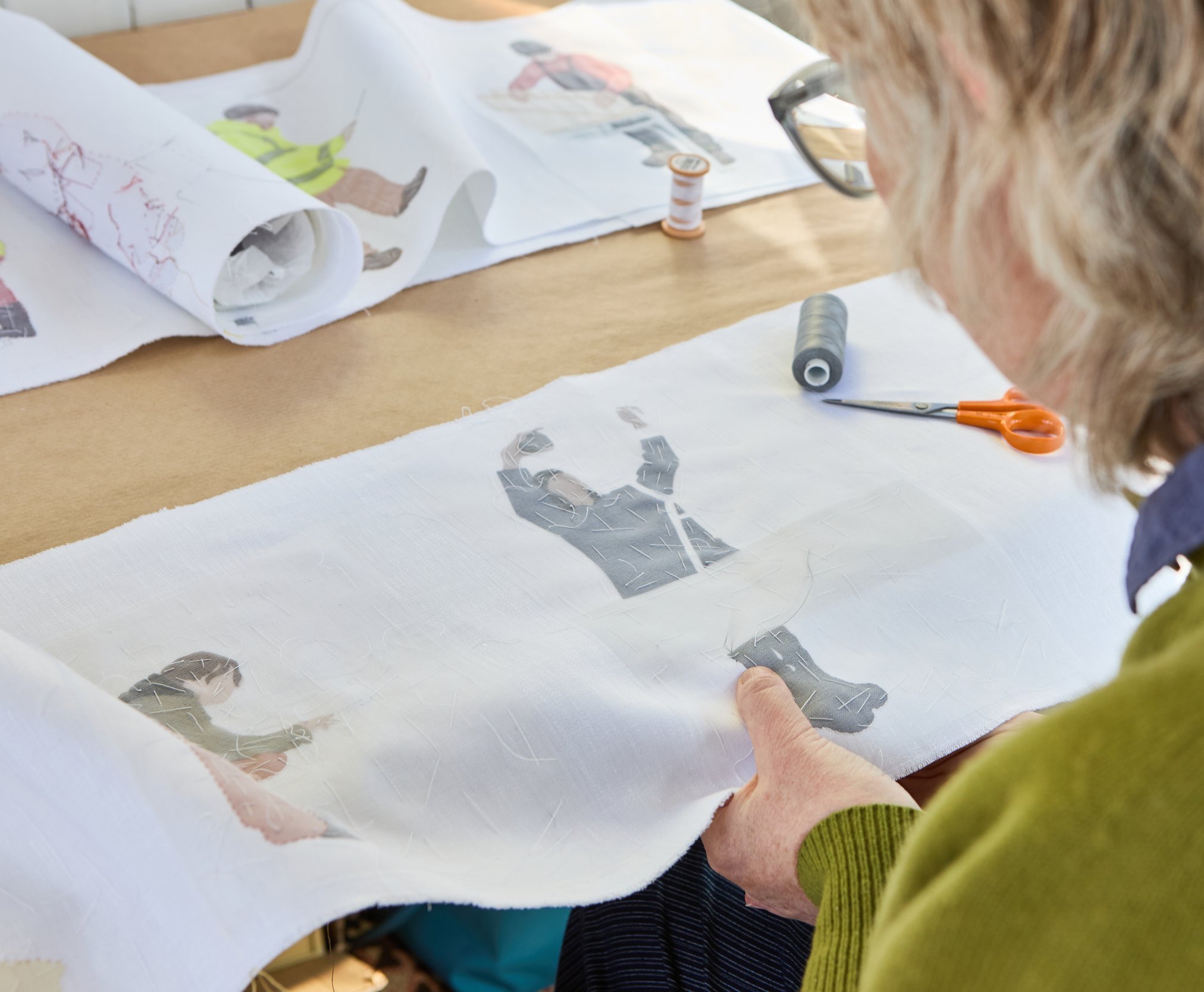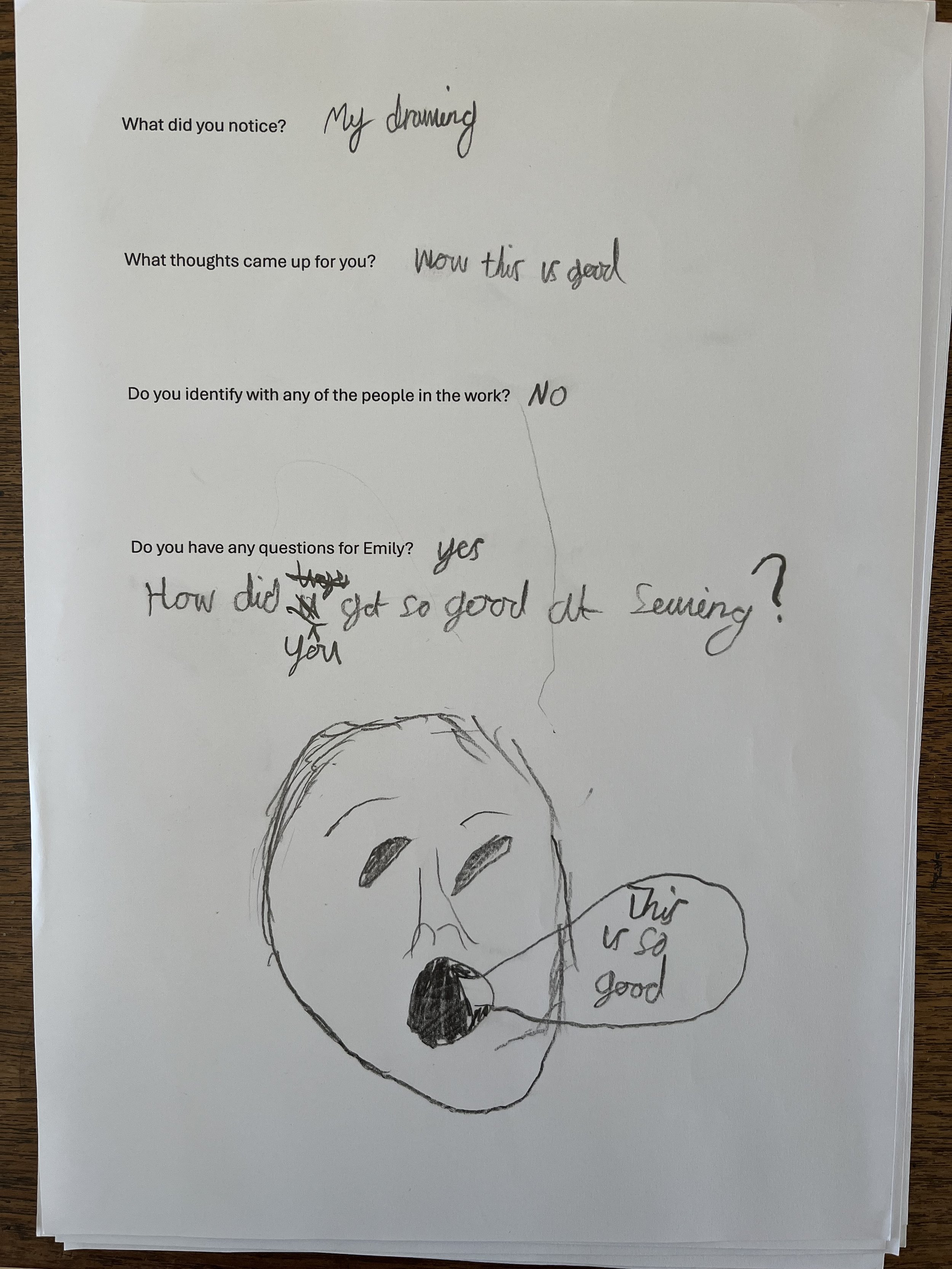London Craft Week - Artist in Residence at Trinity Buoy Wharf - Shining a Light Exhibition
Prop Makers from English National Opera, finding themselves in Emily’s procession of Makers.
“Such beautiful work Emily and a wonderful insight into what an amazing creative place this is with such a variety of interesting talent, your work makes me feel like I know these lovely people a little.”
I was delighted to be appointed Artist in Residence at Trinity Buoy Wharf in November 2024 initially for a 6-month period, culminating with a show during London Craft Week.
The project I proposed was to make a body of work about the Wharf, to shine a light on the expertise within the TWB community and make audiences curious about what people do here. I imagined the resulting body of work, informed by interactions with the community over the period of the residency might create a physical visual diary, comprised of stitched works and drawings. I tried not to tie myself down too much, giving myself the opportunity for the work to evolve.
I spent the first few weeks of my residency working from the Cafe and the Lighthouse. Being visible in the Cafe was a great way of getting to know some of the people based here. From the lighthouse you can see the comings and goings anonymously.
Early on I made some sketches of workman who it tuned out were repairing the river wall. These initial sketches happened to be in a small concertina sketch book. I liked how the figures seemed to travel across the pages and that sparked the idea to stitch a procession of people. Mostly people who work with their hands. So far the procession features over 20 people.
Brilliantly my residency has been extended by a further 6-months, I knew this well ahead of this exhibition, which allowed me to think of the exhibition not as an end point. Knowing there would be time to add other people and to do more things. I thought it would be really exciting to show the work unfinished and for the viewer to see how the applique looks at different stages as stitches are put in and taken out. I invited the audience to comment if they had a view about seeing this process, or some other aspect of the project.
The tacking stitches used to hold the layers in place as the work is constructed are usually removed. These stitches are lightly placed, but a crucial part of the process. They create lively marks in contrast to the very precise small stitches that I employ to encase each coloured element. There is a tension in the decision to leave these in or take them out. I really like the idea that they represent all the hidden work there is when making something difficult look effortless.
English National Opera Prop Makers
I loved visiting the ENO workshop, I had been a bit intimidated by the big doors but having got past those, everyone couldn’t have been more welcoming.
Josie Maprayil
Came to prop making via an English Literature degree, a passion for motorcycles to becoming a Welder.
Claire Esnault
Studied fine art, turns her had to all things prop making. Specialises in paint effects.
Mikaela Hale
Came first to the ENO on a work placement. Studied prop making at Rochester.
Will Fair
Graduate Artist Blacksmithing, Hereford Collage of Art. Part of The SS Robin Restoration Crew. “I think my favourite thing about my job is that I get to work in London for a stable salary and flexible hours with high levels of independence, whilst somehow also working with wrought iron and furthering my artistic practices. That and I get to listen music which is nice!” Will
Thames Clippers’ Engineers
Tammy - Marine Engineer
Just qualified, always the apprentice poster girl.
Audience Reaction
What did you notice? I loved the tacking stitch it adds another layer to the portrait and obvious use of the hand and therefore lovely connection between you and the artist and the person you have observed at work. Carolyn 14 5 25.
What thoughts came up for you? It's really nice to see the whorf community all snitched together. Sometimes as a maker you’re stuck in your own little bubble in the studio, and forget all these amazing lives are being lived on your doorstep!
What thoughts came up for you? I love how much character comes across in the stitching of us. I recognise so many faces and mannerisms captured great job Emily. - Ray
Wonderful work, Emily. It’s lovely to see it come together after spotting you hard at work in the café or the wheelhouse and feels wonderfully meaningful to be a face of it. Glad to hear you are doing more. I hear Kofo would love to feature. -Will
Such beautiful work Emily and a wonderful insight into what an amazing creative place this is with such a variety of interesting talent your work makes me feel like I know these lovely people a little. - Wendy
Do you identify with any of the people in the work? I’m in it! I Love how emily has found all the hidden details + brought them alive! Just Wonderful. ThanK you xx
Exhibited alongside my work were over one hundred portraits made by young people at primary schools as part of the residency program.
I visited Globe Primary School in Bethnal Green and The Faraday School at Trinity Buoy Wharf, to deliver textile workshops. Depending on the session, kids had between 1hr45 and 2hr30 to draw, stitch and appliqué their portraits. In the longer classes there was more time to explore different stitches. Some children demonstrated the stitch knowledge they already had.
Many thanks to the Teachers and TA’s for their enthusiasm and needle threading!
We also made portraits with teenagers with Libby and Minnie at the Trinity Buoy Wharf Saturday Club.
I love the observations from the school children, who came to visit my exhibition. One person noticed that I’d stitched lines to represent the creases in the peoples clothes. They also wondered why I had used pale colours. What great looking.
Other people enjoyed finding their own portraits, that they drawn and stitched.
And there are some great questions! Which I have answered below:
How long did it take you to get used to the needle? I started sewing when I was five or six, I’ve had a had a long time to get used to using a needle.
Have you met any other artist like you? Yes I know lots of other textile artists, some of the artists I’ve met through the 62 group (a group of Textile Artists) I’m also a member of Contemporary Applied Arts and the Art Workers Guild.
How did you get so good at sewing? You get good at things by practising. I’ve been making things and sewing things all my life.
Do you sew your own clothes? I repair my own clothes. I used to make my own clothes when I was younger and I learnt a lot about sewing and construction and making things for making clothes with my mum.
What inspired you? I’m inspired by the idea of making work about people who make things and celebrating them. This long ribbon of makers was inspired by seeing the civil engineers working on the river wall in their high vis clothes, I really liked that image in my concertina sketchbook and that led to the idea of a procession of makers.
Why did Emily sew these people? I have specifically chosen to sew these people, because they other people that work with their hands and I want to celebrate people like them.
How much time did it take? I’ve been stitching the work for about four months not full-time, but about two - three days a week.
Did you use a template for the embroidery? Yes, I make a drawing that I use to make the template to cut the shapes and to help me know where I’m going to sew.
What inspired you to become an artist? I’ve always really enjoyed making things and felt that that was my best skill, so that’s what I wanted to do as a job.
Do you crochet? I have done some crocheting in the past, but I’ve not done it for a long time so you might have to remind me how to do it.
What made you want to do sewing? When I was younger you couldn’t necessarily just go and buy things that you wanted. But there was a feeling in our family if you wanted something, you could probably make it. I was interested in learning to sew so I could make the things I wanted. I also discovered that I really loved making things and I got a huge sense of satisfaction and pride for making things well.















